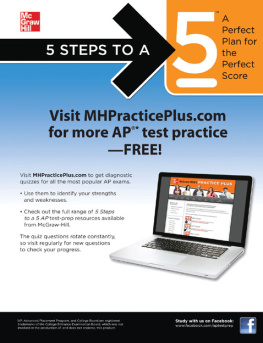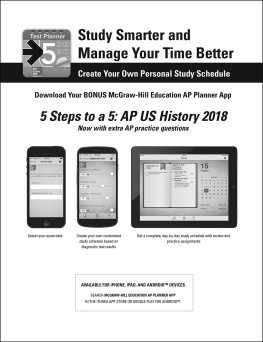Contents
Guide
Page List


Copyright 2019, 2018, 2017, 2016, 2015, 2013 by McGraw-Hill Education. All rights reserved. Except as permitted under the United States Copyright Act of 1976, no part of this publication may be reproduced or distributed in any form or by any means, or stored in a database or retrieval system, without the prior written permission of the publisher. ISBN: 978-1-26-045565-6
MHID: 1-26-045565-3 The material in this eBook also appears in the print version of this title: ISBN: 978-1-26-045564-9,
MHID: 1-26-045564-5. eBook conversion by codeMantra
Version 1.0 All trademarks are trademarks of their respective owners. Rather than put a trademark symbol after every occurrence of a trademarked name, we use names in an editorial fashion only, and to the benefit of the trademark owner, with no intention of infringement of the trademark.
Where such designations appear in this book, they have been printed with initial caps. McGraw-Hill Education eBooks are available at special quantity discounts to use as premiums and sales promotions or for use in corporate training programs. To contact a representative, please visit the Contact Us page at www.mhprofessional.com. McGraw-Hill Education, the McGraw-Hill Education logo, 5 Steps to a 5, and related trade dress are trademarks or registered trademarks of McGraw-Hill Education and/or its affiliates in the United States and other countries and may not be used without written permission. All other trademarks are the property of their respective owners. AP, Advanced Placement Program, and College Board are registered trademarks of the College Board, which was not involved in the production of, and does not endorse, this product. AP, Advanced Placement Program, and College Board are registered trademarks of the College Board, which was not involved in the production of, and does not endorse, this product.
The series editor was Grace Freedson, and the project editor was Del Franz. Series design by Jane Tenenbaum. TERMS OF USE This is a copyrighted work and McGraw-Hill Education and its licensors reserve all rights in and to the work. Use of this work is subject to these terms. Except as permitted under the Copyright Act of 1976 and the right to store and retrieve one copy of the work, you may not decompile, disassemble, reverse engineer, reproduce, modify, create derivative works based upon, transmit, distribute, disseminate, sell, publish or sublicense the work or any part of it without McGraw-Hill Educations prior consent. You may use the work for your own noncommercial and personal use; any other use of the work is strictly prohibited.
Your right to use the work may be terminated if you fail to comply with these terms. THE WORK IS PROVIDED AS IS. McGRAW-HILL EDUCATION AND ITS LICENSORS MAKE NO GUARANTEES OR WARRANTIES AS TO THE ACCURACY, ADEQUACY OR COMPLETENESS OF OR RESULTS TO BE OBTAINED FROM USING THE WORK, INCLUDING ANY INFORMATION THAT CAN BE ACCESSED THROUGH THE WORK VIA HYPERLINK OR OTHERWISE, AND EXPRESSLY DISCLAIM ANY WARRANTY, EXPRESS OR IMPLIED, INCLUDING BUT NOT LIMITED TO IMPLIED WARRANTIES OF MERCHANTABILITY OR FITNESS FOR A PARTICULAR PURPOSE. McGraw-Hill Education and its licensors do not warrant or guarantee that the functions contained in the work will meet your requirements or that its operation will be uninterrupted or error free. Neither McGraw-Hill Education nor its licensors shall be liable to you or anyone else for any inaccuracy, error or omission, regardless of cause, in the work or for any damages resulting therefrom. McGraw-Hill Education has no responsibility for the content of any information accessed through the work.
Under no circumstances shall McGraw-Hill Education and/or its licensors be liable for any indirect, incidental, special, punitive, consequential or similar damages that result from the use of or inability to use the work, even if any of them has been advised of the possibility of such damages. This limitation of liability shall apply to any claim or cause whatsoever whether such claim or cause arises in contract, tort or otherwise.
CONTENTS
STEP 1
Set Up
Your Study PlanDEDICATION AND ACKNOWLEDGMENTS
To
My wife, Mary
My daughters, Janet and Karen I could not have written this book without the help of the following people: My high school calculus teacher,
Michael Cantor, who taught me calculus. Professor
Leslie Beebe, who taught me how to write.
David Pickman, who fixed my computer and taught me Equation Editor.
Robert Teseo and his calculus students who field-tested many of the problems.
Allison Litvack, Rich Peck, and
Liz Spiegel, who proofread sections of the Practice Tests.
Allison Litvack, Rich Peck, and
Liz Spiegel, who proofread sections of the Practice Tests.
And a special thanks to Trisha Ho, who edited . Mark Reynolds, who proofread part of the manuscript. Maxine Lifshitz, who offered many helpful comments and suggestions. Grace Freedson, Del Franz, Vasundhara Sawhney, and Charles Wall for all their assistance. Sam Lee and Derek Ma, who were on 24-hour call for technical support. My older daughter, Janet, for not killing me for missing one of her concerts.
My younger daughter, Karen, who helped me with many of the computer graphics. My wife, Mary, who gave me many ideas for the book and who often has more confidence in me than I have in myself.
PREFACE
Congratulations! You are an AP Calculus student. Not too shabby! As you know, AP Calculus is one of the most challenging subjects in high school. You are studying mathematical ideas that helped change the world. Not that long ago, calculus was taught at the graduate level.
Today, smart young people like yourself study calculus in high school. Most colleges will give you credit if you score a 3 or more on the AP Calculus BC Exam. So how do you do well on the AP Calculus BC Exam? How do you get a 5? Well, youve already taken the first step. Youre reading this book. The next thing you need to do is to make sure that you understand the materials and do the practice problems. In recent years, the AP Calculus exams have gone through many changes.
For example, today the questions no longer stress long and tedious algebraic manipulations. Instead, you are expected to be able to solve a broad range of problems including problems presented to you in the form of a graph, a chart, or a word problem. For many of the questions, you are also expected to use your calculator to find the solutions. After having taught AP Calculus for many years and having spoken to students and other calculus teachers, we understand some of the difficulties that students might encounter with the AP Calculus exams. For example, some students have complained about not being able to visualize what the question was asking and other students said that even when the solution was given, they could not follow the steps. Under these circumstances, who wouldnt be frustrated? In this book, we have addressed these issues.
Whenever possible, problems are accompanied by diagrams, and solutions are presented in a step-by-step manner. The graphing calculator is used extensively whenever it is permitted. The book also begins with a chapter on limits and continuity. These topics are normally taught in a pre-calculus course. If youre familiar with these concepts, you might skip this chapter and begin with . So how do you get a 5 on the AP Calculus BC Exam? Step 1: Set up your study program by selecting one of the three study plans in of this book.





 Copyright 2019, 2018, 2017, 2016, 2015, 2013 by McGraw-Hill Education. All rights reserved. Except as permitted under the United States Copyright Act of 1976, no part of this publication may be reproduced or distributed in any form or by any means, or stored in a database or retrieval system, without the prior written permission of the publisher. ISBN: 978-1-26-045565-6
Copyright 2019, 2018, 2017, 2016, 2015, 2013 by McGraw-Hill Education. All rights reserved. Except as permitted under the United States Copyright Act of 1976, no part of this publication may be reproduced or distributed in any form or by any means, or stored in a database or retrieval system, without the prior written permission of the publisher. ISBN: 978-1-26-045565-6